Brentford
Brentford was formed as an offshoot of the Brentford Rowing Club at a meeting held in the Oxford and Cambridge Hotel at Kew Bridge. The question of which code to adopt was left to a second meeting when, by eight votes to five, association rules were chosen. At the same meeting, it was agreed to play in the salmon, claret and light blue shirts of the rowing club. Some time later these were replaced by claret and blue shirts.
The club's nickname, "The Bees" was coined around 1893 by students from the Borough Road College who started attending matches and whose rallying cry, "Buck up Bs" was taken by spectators as "Buck up Bees." This was taken up by the local press and within a short time, the name had stuck. In 1898 Brentfordjoined the Southern League but a year later they were fined and suspended for a month by the FA for breaching the amateur rules. As a result they turned professional. In 1903 they adopted the gold and blue racing colours of their patron, Lord Rothschild and a year later they moved into their present home, Griffin Park. According to100 Years of Brentford (1989), “Just before the (1909-10) season started, a long time supporter of the club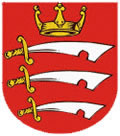 donated them a set of jerseys. The colours he had chosen were not the traditional gold/blue stripes though, consisting instead of a gold body with a blue ‘V’ on the front, a blue collar, blue laced front and blue sleeves and they also bore a badge bearing the Middlesex County arms. The kit was based on a design first worn by Manchester Utd in the 1909 Cup Final. Brentford were not in a position to look such a gift horse in the mouth, for new kits were costing them about £70 a season, so they gladly accepted the donation.”
donated them a set of jerseys. The colours he had chosen were not the traditional gold/blue stripes though, consisting instead of a gold body with a blue ‘V’ on the front, a blue collar, blue laced front and blue sleeves and they also bore a badge bearing the Middlesex County arms. The kit was based on a design first worn by Manchester Utd in the 1909 Cup Final. Brentford were not in a position to look such a gift horse in the mouth, for new kits were costing them about £70 a season, so they gladly accepted the donation.”
After 12 modest seasons in the Southern League First Division, Brentford were relegated to Division Two in 1912. After the end of World War One, Brentford were elevated to a reconstituted Southern League Division One and, as a result, they became founder members of the Third Division of the Football League in 1920, changing their colours to plain white shirts for the occasion. After surviving re-election in their first season, the Bees settled into mid-table obscurity. The now famous red and white stripes were introduced in 1925 and there followed a series of strong campaigns between 1930 and 1933 that brought them the Third Division (South) championship. In 1935 Brentford shocked everyone by winning the Second Division championship and taking their place in  Division One. Far from being out of their depth, the newcomers finished fifth in their first ever season at the top level and in sixth position for the two seasons after that.
Division One. Far from being out of their depth, the newcomers finished fifth in their first ever season at the top level and in sixth position for the two seasons after that.
For the 1938-39 season, Brentford added the crest of the borough of Brentford & Chiswick to their shirts.
After the six year interruption caused by the Second World War, Brentford's fortunes took a turn for the worse. Relegated at the end of the first League season in 1947, they dropped back into the Third Division (South) in 1954. In 1960, in an effort to change their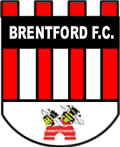 luck, the club revived their old gold and blue colours but to no effect. At the end of the season they were relegated to the Fourth Division. The stripes returned and Brentford were Fourth Division champions the following season but there was to be no dramatic return to the higher levels of the League. For the rest of the decade and throughout the 1970s, Brentford moved between the bottom two divisions. A
luck, the club revived their old gold and blue colours but to no effect. At the end of the season they were relegated to the Fourth Division. The stripes returned and Brentford were Fourth Division champions the following season but there was to be no dramatic return to the higher levels of the League. For the rest of the decade and throughout the 1970s, Brentford moved between the bottom two divisions. A 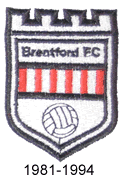 new club crest was introduced in 1976 and worn until 1981 when a revised version was introduced.
new club crest was introduced in 1976 and worn until 1981 when a revised version was introduced.
During the 1980s Brentford enjoyed a long, settled spell in the Third Division which came to an end in 1992 when they won the championship and promotion to the Second Division (renamed Division One following the formation of the Premier League) after a 45-year absence. They lasted for only one season before returning to Division Two (the old Third Division).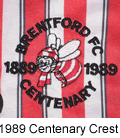
In 1989 the club celebrated their centenary and for the 1989-90 season the usual crest was replaced with a cartoon bee surrounded by suitable wording, one of the worst special anniversary crests ever produced, mercifully retired after just one season.
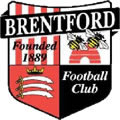 A new crest, designed by supporter, Andrew Henning, was introduced in 1994, which combines the beehive motif with the Middlesex arms and the teams traditional red and white stripes.
A new crest, designed by supporter, Andrew Henning, was introduced in 1994, which combines the beehive motif with the Middlesex arms and the teams traditional red and white stripes.
Relegated again in 1998, Brentford bounced straight back in 1999. In 2002 they were minutes away from automatic promotion on the last day of the season but found themselves in the play-offs instead, where they lost out to Stoke City.
in January 2006 the club was taken over by the Brentford Supporters' Trust (known as Bees United) and Greg Dyke, former Director-General of the BBC and a fan of the Bees was appointed chairman. Their fortunes did not improve and in 2007 they were relegated to League Two, the fourth tier but in 2009 they won the League Two championship and returned to the third tier. In August 2009, Bees United entered into a partnership with Matthew Benham, a professional gambler and CEO of Smartodds, to inject finance and management expertise into the club.
